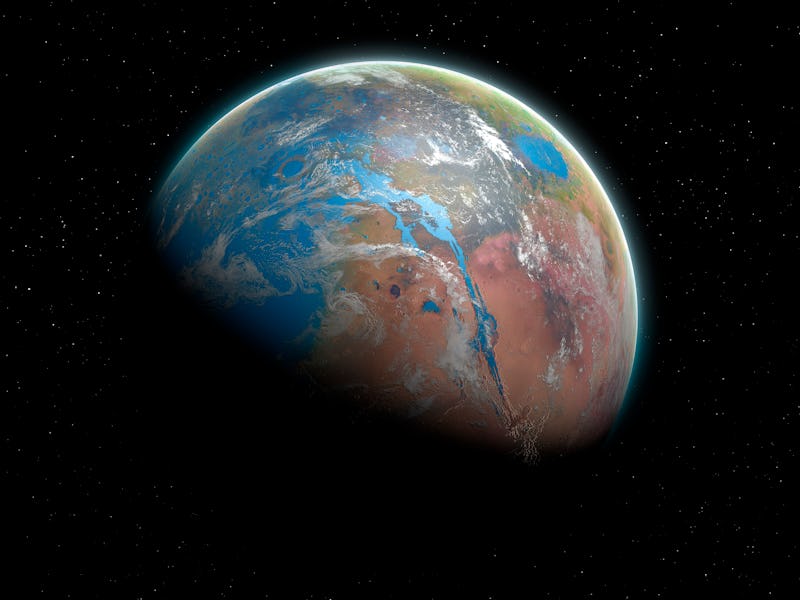Scientists figured out how to solve an ancient Martian mystery — with rocks found on Earth
Martian meteorites found their way to Earth. In turn, they bore a chemical that has the secret to how much water was on ancient Mars.

Figuring out what’s left of Mars’ water on the drier than bone-dry planet isn’t easy — much is trapped below the surface. But a paper published this week by an international team in Science Advances proposes a new way to estimate it that sidesteps the issue completely: instead of measuring water that’s found on Mars, it focuses on measuring chromium in Martian rocks that have made it to Earth.
Here’s the background — It’s clear that while Mars once had seas of its own. What’s less clear is just how much water there was. Because Mars’ water cover in the deep past has broadly been derived from geomorphology — the study of the Martian landscape, including its ancient shorelines — inconsistencies in the surface muddy exact estimates.
If you spread the water evenly across the entire surface of the planet, the lowest estimates would be around 100 meters; the highest would be about 15 times that. (By comparison, if you spread Earth’s water around evenly, it would rise to about 2700 meters.)
Where did that water come from? Much of it likely came from the catastrophic outgassing of the planet’s mantle as it cooled and solidified into its plate tectonics-less crust.
WHAT’S NEW — But that isn’t the only source. Mars has been heavily bombarded by asteroids across its history, but never as heavily as when it was in its infancy. Speaking with Inverse, Martin Bizzarro, director of the Centre for Star and Planet Formation at the University of Copenhagen, explains that “this material could be water-rich and, hence, provide a source of volatiles to nascent planets.” To figure out if these asteroids were water-rich or not, Bizzarro and his team had to determine just what kind of asteroids they were.
Luckily, they had two factors working in their favor. First, astronomers and cosmochemists have pieced together the differences in composition between drier asteroids that tended to hang out in the inner Solar System and icier asteroids that formed far from the Sun in the outer Solar System. And second, Mars’ lack of plate tectonics means that the ancient impacts of asteroids from the planet’s infancy, billions of years ago, are still preserved in the crust.
That means that sometimes, when a bit of Mars is ejected in some later event only to end up on Earth, traces of those asteroids that once bombarded the Red Planet eons before were carried along with it. Some of the meteorites from Mars that have arrived on Earth, Bizzarro says, “are lavas erupted at the surface of the planet. Just like on Earth… it has to travel through he crust and sometimes assimilates part of the crustal material when it rises to the surface.” In other words, they carry within them the isotopes of ancient impacts.
NWA 817, a Mars meteorite that was reported in a 2002 paper to have evidence of water on ancient Mars.
What it matters — By looking at the isotopic makeup of chromium in these bits of lava, Bizzarro explains, “we can use this variation… as a fingerprint of their formation region, a bit like DNA.” And in this case, the rocks’ “DNA” points towards the water-rich asteroids of the outer Solar System, where carbonaceous chondrites formed in the same region as comets.
By comparing the amounts of chromium that came from these asteroids to the amount that came from the planet’s crust, the team was able to calculate how many of these icy asteroids impacted Mars in its first hundred million years: at least 4.5 x 10^20 kilograms, or 4.9 × 10^17 tons’ worth.
So how much water is that?
Assuming, conservatively, that those asteroids were 10 percent ice, that’s still enough water to cover the whole of Mars in just over 300 meters’ worth of seas.
But this isn’t all, emphasizes Bizzarro. Carbonaceous chondrites, after all, are called that because they contain large amounts of carbon, including complex organic compounds. If Mars’ water was delivered by icy carbonaceous chondrites, that “provides an additional ingredient required for life.”
“Two key ingredients required for life to emerge, water and prebiotic chemistry,” he adds, “were delivered to Mars during the first 100 million years of the planet’s history… if they delivered water, they must also have delivered organics.”
What’s next — Right now the only Martian rocks available for analysis like this are those that were ejected before landing here on Earth. But that is likely to change in the next decade. The samples gathered by NASA’s Perseverance rover are already slated for a return to Earth in 2033.
Getting access to those samples, Bizzarro says, “would allow us to directly determine the chromium isotope of the primordial crust that has been affected by the bombardment,” which “would be pretty cool.”
This article was originally published on